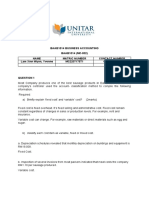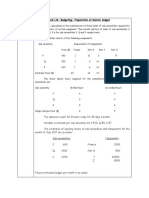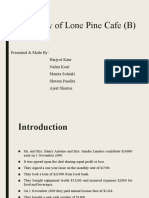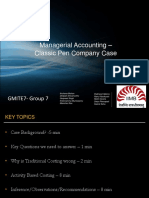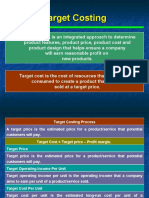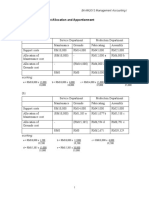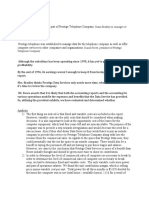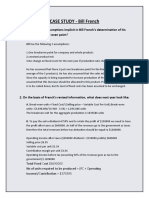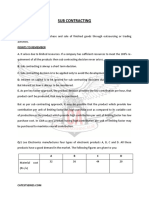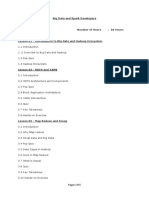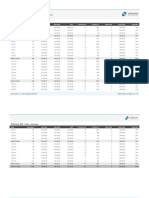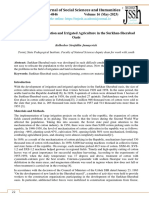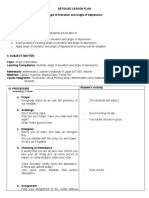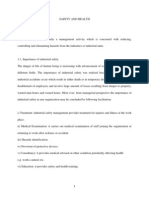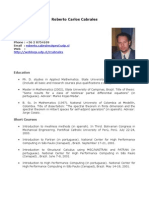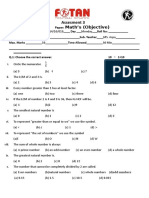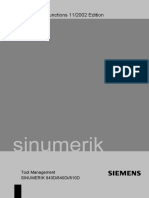Survey Master LLC
GSM5301: ACCOUNTING FOR DECISION MAKING
PUTRA BUSINESS SCHOOL
GROUP ASSIGNMENT
Survey Masters LLC
Group 4
Abdul Hakim Bin Sahaq
PBS15311279
Amar Hamka
PBS15111011
Arunachalam Balaji
PBS15211174
Badrul Hisham Ismail
PBS15311272
Low Jun Xian
PBS15311277
Neeshanthinee Nagoor
PBS15311266
�Survey Master LLC
Case Introduction
Survey Masters is a marketing research company which offers survey & research services to
companies with no specialized research resources. It focuses on various industries such as
manufacturing, retailing, and consulting industries. The company is operated by two main
partners Natalie Patel and Carlos Lopez.
The major line of business which Survey Master focuses is doing market research and conduct
industry specific surveys for their clients. This includes researching on the existing consumers as
well as research on new products and services offered by manufacturers, distributors, and
consultants. Survey Masters implemented a three-phase methodology in conducting survey for
clients. These three-phases includes survey proposal and design, data collection and analysis and
report preparation.
After two years of successful operating, the company now employs 10 professionals, and earned
$3 million revenues with $600,000 income in 2006. The partners Carlos and Natalie has
concerns around selection of their clients in order for the betterment of the company. They are
planning to be more selective in the types and size of the projects that the company should
engage with. The following case study analyses this issue further into detail.
�Survey Master LLC
Question 1: Comment on the analyses prepared by Linda Evans in Exhibit 2. Why do
smaller projects appear to be more or at least equally profitable as larger projects?
The cost driver for overhead is Salary, which is $400,000 for both largest and smallest projects.
As a result, the profit margin for smallest 100 projects is calculated $400,000 which is $200,000
more than largest projects $200,000. Similarly when dividing projects into largest 60 projects
and smallest 60 projects based on revenue, the former profit margin is $300,000 each which
equals to the latter profit margin.
However the cost driver chosen for cost allocation is not reasonable. Larger projects required
more analysts in number and more senior analysts with more experience. Thus the salaries for
largest projects are greater or equal to the ones for smallest project.
Overhead on the other hand, is more related with activities rather than with salaries. The factor
that truly affect overhead expenses are costs related to travelling, phone calls, time and
stationeries. Therefore the best method to allocate overhead costs is Activity Based Costing.
According to both calculations done by Linda, it unable to show the relationship between project
size and project profitability clearly as it is not calculated according the three activities provided
by Master Survey LLC. In summary, Activity Base Costing (ABC) method should be applied.
The ABC process attempts to provide a better model of the costs of producing products or
providing services and delivering them to customers. It promises to depict costs more accurately
through a deeper understanding both of the activities involved and the resources consumed by
each of those activities.
Question 2: Use the information in Exhibit 3 on overhead spending and activities to
prepare analyses of the profitability of larger (20 projects) and smaller (100 projects)
2
�Survey Master LLC
projects undertaken by Survey Master in 2006. What are your conclusions about the
relationship between project size and project profitability?
Table 1: Overhead Allocation Basis
Overhead
Survey Proposed and
Design (Trips)
Data Collection &
Tabulation (Days)
Analysis and Report
Preparation (Pages)
Largest 20 Projects
50
Smallest 100 Projects
110
600
3600
250
1050
Table 2: Overhead Allocation Table
Overhead
Largest 20 Projects
Smallest 100 Projects
Survey Proposed and
Design (Trips)
Data Collection &
Tabulation (Days)
Analysis and Report
Preparation (Pages)
Total Overhead
200000+52587+75000=327,587 440000+317143+315000=1,072,143
Costs
�Survey Master LLC
Table 3: Profit Calculation Table
Revenue
Salaries
Total Overhead Costs
Profit
Largest 20 Projects
1,300,000
(400,000)
(327,587)
372,143
Smallest 100 Projects
1,500,000
(400,000)
(1,072,143)
27,857
We want to allocated the overhead costs according to the new basis, hence we calculated the
overhead allocation based on the given figures which are shown in Table 2 and we found out that
the total overhead costs for the Largest 20 Projects are $327,587 while the total overhead costs for
Smallest 20 Projects are $1,072,143. From here, we can see that smaller projects has absorbed a
big portion of the overhead costs which is tallied with Lindas comment of smaller projects require
many trips, more data collection and more data and analysis. Furthermore, we have calculated the
new profit level for both of the segregated projects. As per results in Table 3, we discovered that
the Largest Projects has a much higher profit than the Smallest 100 Projects.
Question 3: Should Survey Master continue to take all projects offered to the company?
Why or why not? On which size of project should they focus their sales efforts? Should
they refuse to take on larger or smaller projects in the future? What should be their
strategy in selecting future projects to undertake with client?
�Survey Master LLC
Survey proposed and design
Large project
50 trips
Small project
110 trips
Total
160 trips
Data Collection and tabulation
600 days
3600 days
4200 days
Analysis and report
preparation
250 pages
1050 pages
1300 pages
Large project
Small project
Total
Fixed cost apportionment in $
2
Survey proposed and design
00,000
4
40,000
640,000
3
Data Collection and tabulation
52,857
17,143
370,000
Analysis and report
preparation
75,000
315,000
390,000
1,0
27,857
72,143
Large project
Small project
Revenue (per project)
Variable cost (Salary per
project)
65,000
15,000
20,000
4,000
Contribution
45,000
11,000
20
100
Number of project
9
5
1,
400,000
1,1
�Survey Master LLC
00,000
00,000
3
Apportioned fixed cost
27,857
1,0
72,143
5
Profit
72,143
27,857
Based on the calculation above, the large project recorded higher profit of $572,143 as compared
to small project of $27,857. Since the overhead are apportioned and charged according to the
activities, Survey Master will not incur additional fixed costs should they choose not to take up
small projects. Therefore, it is recommended that Survey Master:
i.
To continue with all current projects di regard of the size, if the Company still be able
to manage through the all projects and do not possess any constraint on resources.
This is to ensure that the Company maintain its presence in the market;
ii.
If the resources are scarce, then sales effort be focused on securing big projects and
be selective on accepting small projects;
iii.
The strategy is to assess the potential revenue on client basis and does not use the
magnitude of the projects as a criterion to accept or reject projects as some clients
may offered both small and big projects, and by rejecting small projects from this
clients may have a potential negative effect on securing bigger projects from the same
clients.
�Survey Master LLC
Question 4: Suppose that Survey Masters decides to only take on larger client projects, but
not enlarge its professional staff (i.e. maintain the level of project salaries at $800000).
Prepare a projection of income for 2007 for the strategy that you proposed in question 3
above.
Answer:
Supposing that the Survey Master decides to only take on larger client projects so the current
salaries of the Largest 20 projects will be duplicated and also the overhead costs and the Total
Revenue.
Description
Income statement
for 2006
Projection of income statement
for 2007
No. of large projects
completed
20 projects
40 projects
Revenue
$ 1,300,000
$ 2,600,000
Salaries
$ 400,000
$ 800,000
Overhead allocated
(based on project
salaries)
$ 327,858
$ 655,716
Net income
$ 572,142
$ 1,144,284


